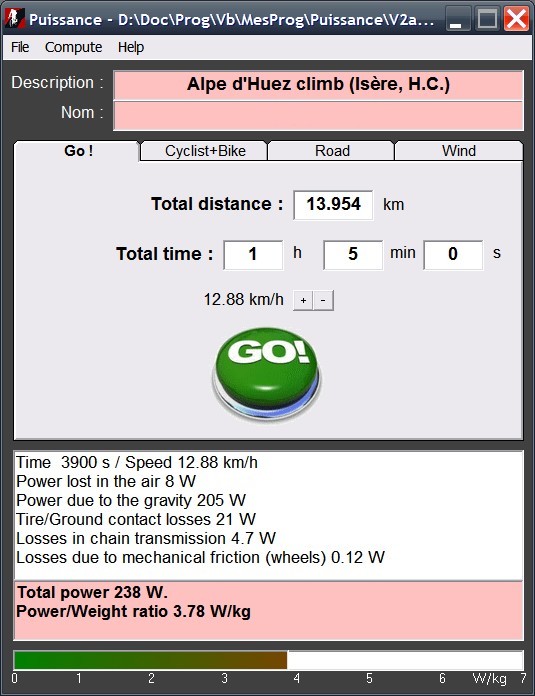|  |
|
|
Welcome to this page, where we talk about the calculation of power in cycling. | ||||
|
If there is a topic interesting lovers of the little queen that arouses many internet pages, it is well the calculation of the power developed by a cyclist on his bike. Hence there are many errors and confusions; For example, the distinction between a resistance, which is a force, and a power, is not always clear. There are also sometimes errors in the calculation of the power to be provided to overcome the resistance of the air. What I am presenting here is the result of a work of reflection based on my knowledge in aggregate physics of mechanical engineering and my readings. I spent time analyzing each parameter and establishing and verifying the validity of each element involved. To synthesize my study, i developed a small software, practical and complete, allowing to calculate with precision the
total power spent by the cyclist, its power / weight ratio and, incidentally, the slope of a climb. I call it "Puissance":  The current version may differ from these screenshot. It seems to be a lot of parameters, but in fact the use of the program is simple because there are only two important parameters: distance and time. A click on "GO!" is already showing results. The other parameters can be changed, but it is not necessary: we can ignore those we want and enter only those that are interesting. Of course, to be precise you can also enter the start and finish altitudes when climbing a pass, a slope or a hill, your weight and the weight of the equipment (bike, clothing, cans, etc.), the face component of the wind speed (negative if the wind is back), and also modify several other parameters. What is interesting is that you can see how a single parameter modifies the results by changing only it. It's easy to change the default values of the parameters by clicking on "Save Parameters" ("File" menu) and choosing the file JimVelo.vlo. They will be reloaded at the next program start as they have been recorded. Moreover, whatever its name, any parameter file created with the program can be reloaded with "Load Parameters". You can create a collection of files, for example one file per summit. It will not be necessary to enter its characteristics (length, altitude, road condition) or personal parameters (weight, cx, front surface): you will have a set of files customized for each rider with his own Cx, his own weight, ... and available for each of his climbs or his time trials. These files will be classified by their location, by creating folders, by name, and by the description line, in which you can write what you want to remember later of the corresponding path. You have just to keep the .vlo extension of these parameter files. The versions before January 2016 used the extension ini. Just rename these old files by giving them the new vlo extension, so that they are recognized by the new versions. The program gives informations on the climb in progress by clicking on "Information on the climb" in the menu "Calculation": altitude, slope,
angle, category according to the author's method, and several other known methods.
Read here my explanations on the classification of climbs in categories. 
Puissance and Gpx filesVisualize the route and the elevation profile your Gpx file with Puissance!  SimulationThe variation of the parameters can easily be simulated:
Use in a professional wayThis program, although developed with all possible care and goodwill, is provided without any warranty; I shall not be held liable for any damages attributable to its use.  Fundamentals of power calculationI will not bore you with a great number of mathematical developments or reasonings of mechanical physics.
As I have already written, many web pages or even scientific articles exist on this subject.
I prefer to remain clear by limiting myself to specifying that the power that the cyclist must provide is the sum of:
Validation by comparisonIn July 2013, Antoine Vayer published an article in Le Monde, named Pour tout comprendre sur la calcul des Watts, in which the past coach of the Festina team explained the principles of calculating the power developed by cyclists in ascending roads. In 2014 and 2015, he continued to collaborate with the newspaper, and took the article as a reference in support of his chronicles published by Le Monde on the Tour de France. The article provides three examples. By taking the first, the most detailed and the most accurate, i have compared the results furnished by "Puissance" and those given by M. Vayer. This is the rise of Christopher Froome to Ax three areas in the stage of July 6, 2013, which he won. It was a climb of 7.85 kilometers with a difference of 648 meters, which the winner carried out in 21 minutes 40 seconds.  Let's compare the results line by line: -power loosed in the air: M.Vayer indicates 45 - 2 (back wind) - 9 (suction) = 34 Watts, Power 28 Watts (shelter in a wheel for 2/3 of the time). The total power provided by M.Froome would therefore have been 436 Watts for the article, and 429 for my software. The difference between the evaluation of the program and that of the article is -2.29%. The good correspondence between our results validates therefore "Puissance". But, in my opinion, Mr. Vayer's calculation of the aerodynamic power still presents two errors, the second of which is of no consequence for this example: on the one hand, it is wrong to raise to the cube the speed of the cyclist to calculate the power lost in air -(21,74 / 3,6)3-, because the resistance due to penetration into the air comes from the speed with respect to the air and not relative to the ground, which leads the author of the article to misjudge the aid, it is true small but not negligible, supplied by the wind, because the speed of the conductor with respect to the air is lower than that in relation to the ground when the wind pushes it; in fact, thanks to this favorable wind, C.Froome must provide 28W to overcome the resistance of the air, instead of 35 if there had been no wind. On the other hand, a frontal surface that is too weak at the same time as a Cx that is too high by a factor of two, compensate in the calculation of the product S.Cx (in my simulation, the above result can be seen, i put realistic values). This is why "Puissance" finds 28 watts (exact value), and M.Vayer 34 (false value according to the author of these lines). You can check this by entering a wind speed that is exactly the opposite of the bike, ie -21.74 km/h; the velocity with respect to the air is then zero, the resistance due to the penetration into the air and the corresponding power also. My software gives 0 in this case. As for subtraction 45-2, it is doubtful because without physical sense; And what about finally this value of 2 watts, of which it is not known how it is calculated? To retrieve this simulation in "Puissance", simply load the file named FroomeAxe.vlo, which was added to Puissance. Obviously, the result, also provided by the software, of a Power per Weight ratio of 6.31 W/kg, is extremely high, and could not remain at this value, even for the winner of the Tours de France 2013, 2015 and 2016, in a longer ascent, because the same power can not be maintained for an hour and for twenty minutes. In other words, the short duration of this ascent does not make it possible to draw conclusions about the possibility of achieving this beautiful feat without doping. This remains a great sporting result.
External links in french: CommentsThere is no comment yet. Be the first to write one!
 |

|

|
